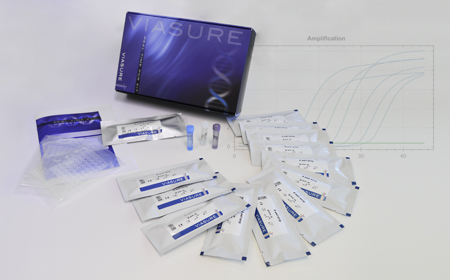
VIASURE Real Time PCR Detection Kits
Herpes virus 1, Herpes virus 2 & Treponema pallidum

Description
VIASURE Herpes virus 1, Herpes virus 2 & Treponema pallidum Real Time PCR Detection Kit is designed for the specific identification and differentiation of Herpes virus 1, Herpes virus 2 and Treponema pallidum in clinical specimens from patients with signs and symptoms of genital ulcer.
This test is intended to be used as an aid in the diagnosis of Herpes virus 1, Herpes virus 2 and Treponema pallidum in combination with clinical and epidemiological risk factors.
DNA is extracted from specimens, multiplied using Real Time amplification and detected using fluorescent reporter dye probes specific for Herpes virus 1, Herpes virus 2 and Treponema pallidum.
Specifications
Information
Treponema pallidum and herpes simplex virus types 1 or 2 (HSV-1/ 2) are the most common sexually transmitted pathogens that cause ulcers of the genital, anal and oropharyngeal region. Genital ulcers are a significant risk factor for transmission and acquisition of human immunodeficiency virus (HIV). Identification of ulcer-causing pathogens is a prerequisite for an effective therapy and reducing the risk of HIV infection.
Genital herpes can be caused by two very similar viruses, herpes simplex virus HSV-1 or HSV-2, being the infections caused by first one more often. Herpes simplex virus (HSV)-1 and -2 are large, double-stranded DNA viruses that cause lifelong persistent infections characterized by periods of quiescence and recurrent disease. These two HSV types cannot be distinguished clinically. In fact, they share a high degree of genetic homology, but they also have specific regions with small nucleotide variations which may allow discrimination. HSV-1 and HSV-2 infection
occurs via inoculation of virus particles into susceptible mucosal surfaces. Afterwards, these neurotropic viruses can become latent in the local sensory ganglion, periodically reactivating to cause symptomatic lesions, or undergo asymptomatic viral release, with the potential for disease transmission and infection. The same treatment is used for both HSV-1 and HSV-2 infections, the location of the lesions and the chronicity of the infection (primary or recurrent) determine dosage and frequency.
The spirochete Treponema pallidum (Tp), the etiologic agent of syphilis, causes a multistage sexually transmitted infection (STI). Pathogenic treponemes cause venereal syphilis, yaws, endemic syphilis, and pinta—multistage, infections that, although similar, can be differentiated based on clinical, epidemiologic, and geographic criteria. Only venereal syphilis is transmitted by sexual activity. The pathogenic treponemes are uncultivatable, slowgrowing microorganisms with identical flat-wave morphologies. They poorly tolerate desiccation, elevated temperature, and ambient oxygen tension, traits that explain why efficient transmission requires close personal contact.
Several types of laboratory test are available for diagnosis of Treponema pallidum and herpes simplex virus types 1 or 2. Serology, dark field microscopy and PCR are the gold standards to diagnose these pathogens. However, Real Time PCR assays have been shown to be a more sensitive and specific diagnosis tool for their detection.

